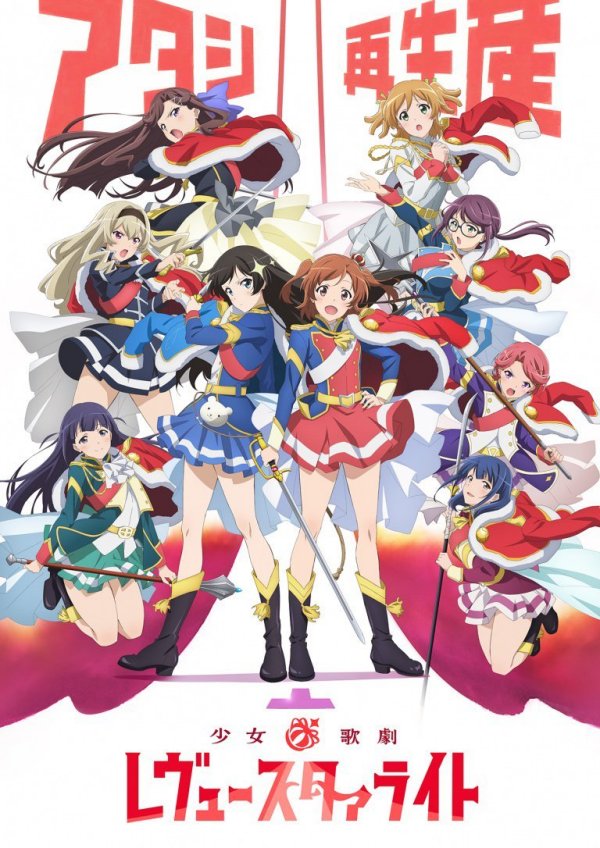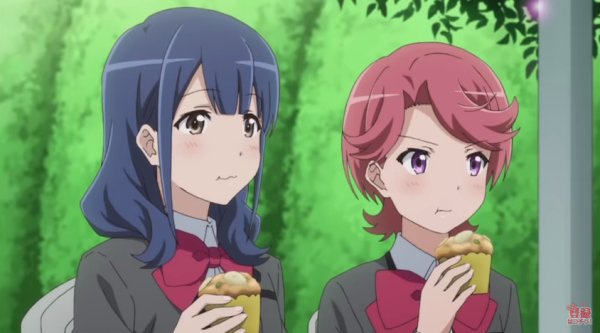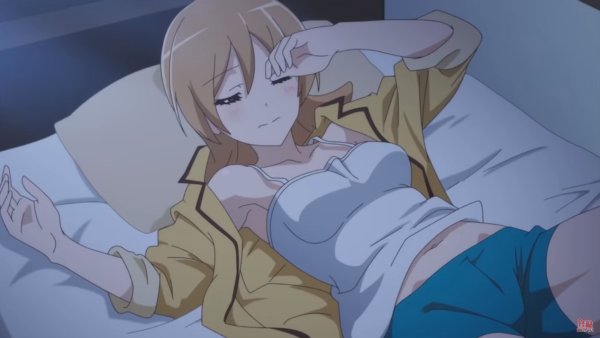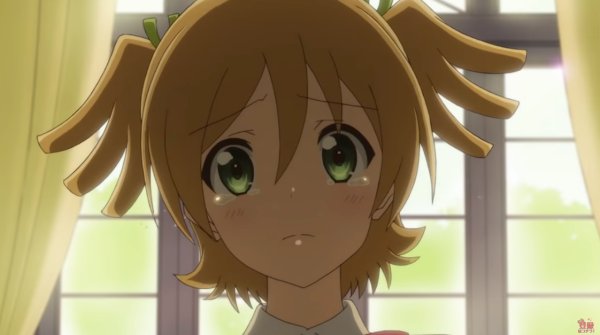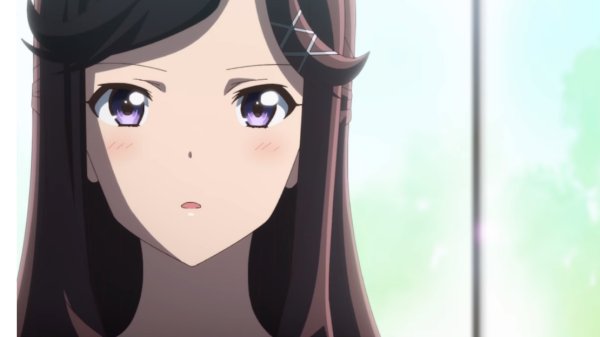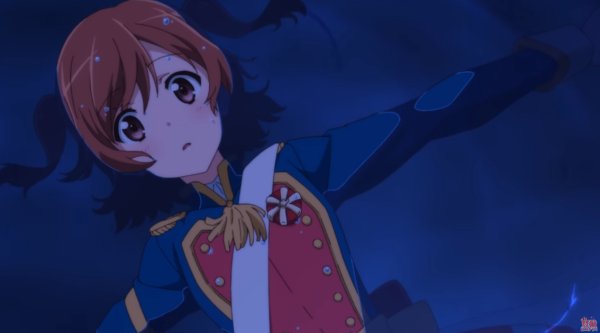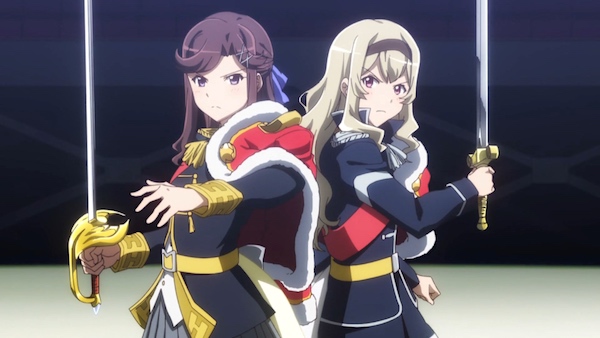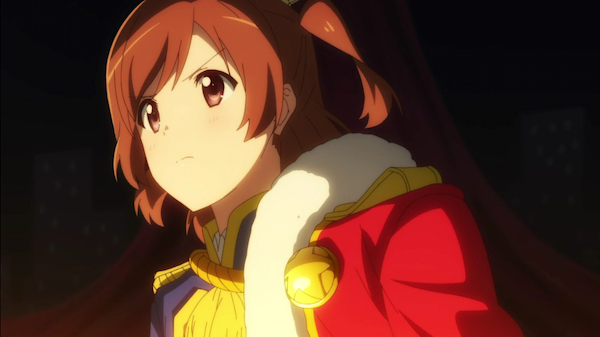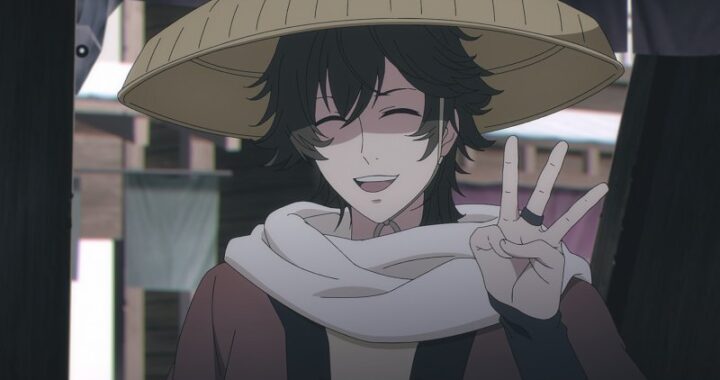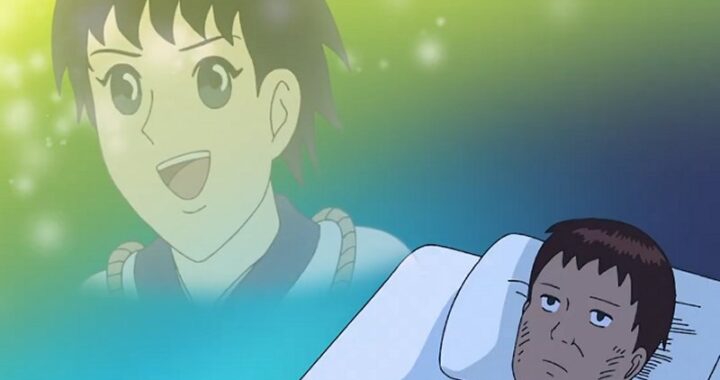 The fight to win the stage, and the wish, continues with the 99th class.
The fight to win the stage, and the wish, continues with the 99th class.
What They Say:
As the 99th graduating class of the Seisho Music Academy prepares for their annual review, “Starlight”, aspiring actress Karen Aijo is happy just to have the chance to be in the cast. But when Karen’s childhood friend Hikari mysteriously arrives after years abroad, Karen quickly learns that there is more going on at Seisho than the normal drama classes.
Following Hikari late one night, Karen discovers an elevator that takes her deep below the Earth, where the secret auditions for the leads in Starlight is underway… a competition that is fought with real weapons as well as song and dance! Goaded by the giraffe in charge of the trials, Karen throws caution to the wind and takes the stage herself… but will she be ready to survive the ultimate contest of drama and skills?
The Review:
Audio:
The audio presentation for this release brings us the original Japanese language track in stereo along with the newly created English language dub. Both tracks are done up in the lossless DTS-HD MA codec and the end result is pretty solid all around. The show works a pretty good mix of action and dialogue to it so that both aspects of it are well served, though it leans more towards dialogue to work the animation budget well. The songs, however, are not dubbed and while I always enjoy when we do get them dubbed, I don’t get frustrated by it because I enjoy both. The action component plays out strong here overall as there are some very good sequences that play out due to the different natures of the characters abilities as well as the scale of it and bringing in some neat effects at times. It’s a good mix that has a really clear nature to it that it steps things up nicely. Dialogue is clean and clear throughout and we didn’t have any problems with dropouts or distortions during regular playback.
Video:
Originally airing in 2018, the transfer for this TV series is presented in its original aspect ratio of 1.78:1 in 1080p using the AVC codec. The twelve episodes are spread across two discs in a nine/three format that gives it plenty of room to work with. Animated by Kinema Citrus, the show has a very good look about it where it’s got a rich color palette to work with, some very good detail in both backgrounds and designs and a solid flow of animation that makes it feel quite fluid in the big sequences. It’s an appealing show visually and the transfer brings it to life well, especially with the costume design. There are a good number of dark scenes here, especially with a lot of the backgrounds, and the result is quite solid in those areas. The pops of vibrancy stand out well with the costumes and big action moments as well but we also get that throughout the smaller scenes and just the little details here and there. This all holds very well with little in the way of noise to it, resulting in a very clean look.
Packaging:
The packaging design for this release brings us a standard sized Blu-ray case that holds the two discs against the interior walls. The main look of the show is played up with the color design here as we get a red background for framing, a touch of additional yellow/gold within that, and the central piece of a great key visual of the core cast together in their performance outfits which bring in the same colors with a good bit of blue and a little more. It’s really nicely designed and detailed and I love the costume design here so much that even though it’s a standard cast shot it works really well for me. The back cover goes a little more traditional as we get a basic murky background over which there are the usual items. The premise is nicely covered and easy to read and the selection of shots from the show are small, a bit vibrant, but mostly ineffective because of their size. The artwork along the top is pretty nice though with the cast all sitting together and lit from underneath. The discs features are clearly listed and we get a solid breakdown of production credits and the technical grid. No show related inserts are included nor is there a reversible cover.
Menu:
The menu design for this release has a very busy design about it and I’m had pressed to really call it consistent when combined with the navigation. The static screens for both use the main red, white, and blue color design of the outfits with a kind of swirling pattern in the background that looks nice. On top of that we get some framing that holds some great illustration material inside set against a white background. It’s clean, colorful, and simple while being appealing. The left side of the screen has a black stripe from top to bottom where the episode titles are in white while the numbering is to the left with it done as a yellow circle that has the white text on top of it. It doesn’t feel like it connects well to the rest of the screen and is kind of “harsh” with the black aspect. That said, everything is functional and loads quickly while including commentary access from the top level in a very easy to navigate way.
Extras:
I will always give extra props when commentary tracks from Japan are included and translated because it involves such a huge effort. Fans of the show will find a lot to like digging into them and I just scratched the surface to get a taste of it and there’s a lot to expand on there. In addition to those, we also get the clean opening and closing sequences, the episode previews that were streamed, and the regular promos. There’s also a cute collection of the shorts that adds a little more humor to things.
While a lot of people know Bushiroad by their cardgames and some of the anime that have been brought out by it, they also engage in properties that you may not think would factor into that kind of ecosphere. Revue Starlight is one of their franchises that got underway in 2017 with a series of musicals which then spawned mobile games, manga, and eventually this anime series which in turn has a compilation film and an original film as well coming out in 2021. That’s a pretty good arc for something and there are a lot of different components that fans can latch onto and engage with while keeping separate from the rest. The anime, arriving in the summer of 2018, came from Kinema Citrus with Tomohiro Furukawa directing based on the scripts from Tatsuto Higuchi. It has a lot of familiar elements to it to be sure in terms of structure, but the property excels at its visual design and presentation.
The premise is one that will give off some vague Utena vibes as we deal with the Seisho Music Academy and with a focus on the 99th graduating class. That gives us a lot of characters to deal with and plenty of the usual things and we see that early on as our focus is through Karen. Karen has been working toward the goal of being on the Revue Starlight stage for years after making a promise to her friend when they were little because it’s such a big, bold, and dazzling event. While the two ended up on different paths because Hikari struggled to get to the same place, they’ve both ended up here and are making friends with others that populate this particular class. The early episodes focus on some of the basic school stuff, friendship, and even how many of them will stick together in a room since there’s a push to bond quickly that’s rather amusing to watch unfold.
With Hikari being the new transfer, Karen is surprised to see her sneaking off in the night and ends up following her, which leads to a really neat underground theater where really competitive auditions take place that have an edge of violence and threat to them. It’s here that she sees that her friend is fighting and struggling against Junna, the class rep who has a pretty good background to her where she’s doing this against her parents wishes. Similar to Hikari, she has her struggles in this arena and is putting in the extra effort to grow and become better, which is frustrating for Karen to watch because she wants to root for her friend. Of course, she’s also told to be quiet and just pay attention by a giraffe that oversees this is standing next to her. This is one of those natural surreal moments you get in a lot of shows focusing on teenage girls to provide insight into various coming of age things and this particular talking giraffe has the extra ability to grant wishes to those that win on this particular stage.
This sets the overall audition/competition/practice design of the show get underway and there are more than enough familiar elements to it. It works well because of the design, costuming, the music, the choreography of it all. It’s a visual delight that has enough to hold it together. But it also spends time on character material that works nicely. Early episodes focus on how Karen’s actual roommate, Mahiru, is hurt by the way that Karen is all about Hikari since the two of them should be bonding a lot more. We do see how Karen becomes a bit of a unifying character as it progresses and makes more friends, which isn’t always easy in a competitive atmosphere like this, but it helps to have some of it and it shows in the growth in how others perform and compete against her on the stage as well. There’s that basic idea of how a single character can really become a catalyst at times and Karen does that well here while often keeping her own place a bit lower so as to not overly dominate even though she’s the central player.
And I do like that the show spends time focusing on some of the others to a better degree than I expect. Nana gets a good bit as a second year that has her memory of last year’s performance strong in her head. Nana’s story is one of the more intriguing ones for me as we see her progress through the competition and utilize her wish in a way that really did surprise, making it clear that Giraffe can do anything, and how it all cycled around to the present. Similarly, another episode focused on Kaoruko ends up showing her feeling alienated from her friends in the midst of everything as she discovers some of them are pursuing other things that will help in the competition without telling her. It’s part of the push and pull of a competitive education where there are real winners and losers as opposed to just everyone graduating together.
In Summary:
There are a lot of philosophical elements of the series that come into play what with the wishes and their meanings, and how often it’s not always what you intended that you end up getting. The final arc of the series definitely plays that route as it puts Hikari into a really bad position and moves the rest of the cast forward in a way that I would normally call a bit listless but is more like a twisted fake epilogue before going into the true final battle. The project is a fascinating one on a lot of levels and I do wonder if it’s something where fans of the same age, generally speaking, will get more out of it than I will being far past that. The allegories are there and easy to see on a basic level but it has some additional depths that give it a lot of solid replay value that I suspect will have people re-evaluating this as the years go on as they get more and more out of each showing. Which is why I’m glad Sentai put it together in such a solid release with the great commentaries included and a strong dub with a great cast that nails it from the portions I listened to. I really think this is a series that may need to be revisited yearly in order to see more and more details and nuance to it with each viewing.
Features:
Japanese 2.0 DTS-HD MA Language, English 2.0 DTS-HD MA Language, English Subtitles, Clean Opening, Clean Closing
Content Grade: B
Audio Grade: B+
Video Grade: B+
Packaging Grade: B+
Menu Grade: B
Extras Grade: A
Released By: Sentai Filmworks
Release Date: April 7th, 2020
MSRP: $69.98
Running Time: 300 Minutes
Video Encoding: 1080p AVC
Aspect Ratio: 1.78:1 Widescreen
Review Equipment:
Sony KDL70R550A 70″ LED 1080P HDTV, Sony PlayStation3 Blu-ray player via HDMI set to 1080p, Onkyo TX-SR605 Receiver and Panasonic SB-TP20S Multi-Channel Speaker System With 100-Watt Subwoofer.



















